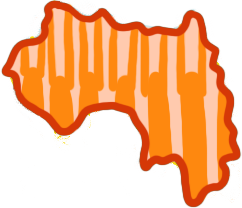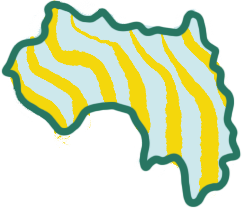Text
In this chapter, we're gonna cover so-called qualitative verbs that allow you to describe the quality of things, so that you can say things equivalent to "I am healthy", "My dad is tall", "That isn't difficult", etc.
Specifically, we'll go over:
- how qualitative verbs are different from "Presentatives"
- affirmative qualitative verb constructions
- negative qualitative verb constructions
Describing the quality of things
Thus far, we've covered "Presentative" sentences. These can be translated with the verb "to be" in English.
For example, a presentative sentence with le/ne:
N kɔdɔ le.
'It's my elder sibling.'
Notice how this kind of constructions is rendered into English with a combination of the verb "to be" and a noun. It presents or identifies a noun.
But what happens if we want to describe a noun and say something like "Guinea is big" or "My mom is tall"?
In this case, we typically use qualitative verbs (which some scholars call things like "predicate adjectives". Don't worry too much about the name; use whichever one is easiest for you.)
Affirmative constructions
Let's tackle qualitative verb constructions with a simple example that you've likely already encountered in the course of greetings:
I ka kɛndɛ?
You VQ.AFF healthy'You are healthy?'
Note that in this example, I have purposely not glossed ka as 'are' or any other form of the verb "to be." This is because—as we have already seen with presentatives and equatives—it's important to not think of there being one word that can be translated as "to be" in Maninka (or Manding in general).
Keeping that in mind, you can see that underlying structure of an affirmative sentence with a qualitative verb then is straightforward:
[NOUN]+ka+[QUAL.VERB]
[NOUN] + is + [QUAL.VERB]
First, we take a noun. It can be a proper name like "Aminata" or a common name like dɔɔ ('younger sibling').
Next, we have the "predicate marker" ka, which is basically a supporting grammatical word that allows to use qualitative verbs in the affirmative.
After that, we can add whichever qualitative verb that we like. They never change regardless of the subject's number, gender, etc., so nothing special to memorize!
In many cases, Maninka qualitative verbs line up nicely with English adjectives, but not always. Some English words used as adjectives related to colors or mood, for instance, require using different kinds of grammatical constructions if you want to express them in Maninka. For now, it's better to start from Maninka by learning some common qualitative verbs via examples. You could say things like:
Fanta ka jan
'Fanta is tall'
Or:
To ka di
'Tô is pleasing'
(as in, "Tô is good/tasty")
(NOTE: To is a West African food dish of a pounded starch that one dips into sauce. Learn more here.)
Or:
Maninkakan ka gbɛlɛn
'Maninka is difficult'
Negative constructions
To use qualitative verbs in negative sentences is very easy! You simply change the predicate marker ka to man. So, for instance, let's imagine you are at a party. You might say something like:
Mɔɔ ka siya!
'People are numerous!' (lit. 'Person is numerous')
(as in, "There's a lot of people!")
If the party was a bust though, you would instead say:
Mɔgɔ man siya!
'People are not numerous!'
► Asking about the quality of something
To ask someone how or what something is like—that is, about the quality of a person or thing (e.g., “Is Adama tall?”)—we can form a question using the word di ‘how’ (or ɲa di [lit. ’manner how’]).
(NOTE: You have learned two distinct words that have the same written form [linguists call such words homonyms] in this chapter: di 'how' and the qualitative verb di 'pleasing'.)
What is unique though is that, though responding will require a qualitative verb, the question does not require the use of ka or man. Instead, we idiomatically use ye (which you will learn more about in a future chapter about situatives.)
For instance, if you were visiting West Africa, someone might ask you:
Laginɛ ye (ɲa) di?
‘Guinea is how?’
(as in, ‘What is Guinea like?’)
And you would respond with a qualitative verb using ka or man:
Guinea ka ɲi!
'Guinea is good!'
(as in, 'Guinea is a good place to be!')
You cannot respond back with ye and a qualitative verb:
Laginɛ ye ɲi!
'Guinea is good!'
The form that you can use or should recognize for asking basic questions about what things are like therefore is:
X ye (ɲa) di?
'X is how?'
►Not adjectives
Qualitative verbs are like adjectives in English when we say things like, "He is not fat," (À man bon) or "Adama is good" (Adama ka ɲi).
But they are not the same.
This is because we cannot simply put any qualitative verb right next to a noun like we can with an adjective in English (e.g., "He is fat" → "the fat man").
For instance, we can say:
Kɛ ka bon
'The man is fat'
But we cannot say:
Kɛ bon
'the fat man'
In a future chapter, we'll cover more of the details about "Adjectives" (including how to turn qualitative verbs into them), but for now, let's just say that you need to have a structure NOUN + ka/man + QUAL.VERB to use a qualitative verb correctly.
Summary
Ayiwa! In this chapter, we covered the following:
-
Qualitative verbs (sometimes called "predicate adjectives") are formed like this:
NOUN +
ka/man+ QUAL.VERB -
Qualitative verbs allow you to make sentences where you describe nouns.
-
To ask a question that requires a qualitative verb, you can use the structure
X bɛ (cogo) di?'X is how?' -
They are like adjectives in English when we say things like, "He is tall," (
À ka jan) or "Adama is good" (Adama ka ɲi). But they are not the same. This is because we CANNOT necessarily use the formjanorɲidirectly next to a noun likecɛto say "the good man" (cɛ ɲi
Vocab
Coming soon n'Ala sɔnna!
- X ka [quality]
- X is [quality]
- ka
-
helper word for qualitative verbs
- X man [quality]
- X isn't [quality]
- man
- negative helper word for qualitative verbs
- X ye di?
- "X is how?" (as in, "What is X like?")
- (ɲa) di
- how (lit. '[manner] how')
- gbɛlɛn
-
difficult
- nɔɔ
- easy
- X sɔnkɔ/da ka gbɛlɛn
- X is expensive (lit. 'The price of X is difficult')
- bon
- large; fat
- jan
- tall; long; far
- sudun
- short; near
- ɲi/ɲin
- good; nice; great
- juu
- bad; mean; evil
- siya
- numerous; abundant; "a lot"
- dɔɔ
- small
- di
- pleasing; tasty
- gbo
- displeasing
- misɛn
- thin; small
- kɛndɛ
- healthy
- fisa
- better
- fadin
- fiery; spicy
- suma
- cool; cold
- kalan
- warm; hot
- kosɛbɛ
- seriously; "very"
- kojuu
- excessively; "too"
- doyin / dɔɔnin / dɔnɛn
- a little bit
- dɛ
- "really"
- kɛ
- "Don't you know?"; "Of course!"
- sisɛn
- now
- fana
- also
- sumaya
- malaria; flu-like symptoms (lit. "coolness")
- Ala ye nɔɔya kɛ
- May God do easing (as in, "Feel better!")
- to
- West African food dish of a pounded starch
- faso
- homeland
- -ka
- -er (as in, London*er*)
- sila [sla]
- road; path
- dawunnin/domuni
- food
- cɛkɛ
- attiéké (a West African dish made of cassava)
- loko
- plantain
- minfen
- drink; beverage
- ji
- water
- bana
- sickness [Maninka/Bambara/Jula]
- jankaro
- sickness [Maninka]
- wadi/wodi
- money
- yiri
- tree
- ko
- affair; matter; thing
- nin/ɲin
- this
- o/wo
- that
- tuun/tuunin
- anymore
- (ko)tuun / tuunin
- again
Vocab list will be here someday!
Flashcards will be here someday!
Exercises
Exercises will be here someday!




